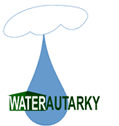
The considerations developed herein are only valid for those who adopt the PLUVALOR system. This choice is a personal, rational and reasoned decision that should strictly remain a private concern.
The text within this page was first published on www.eautarcie.com: in 2003
The original text has been adapted and translated in English by André Leguerrier and was first published on this page at www.eautarcie.org: 2009-10-01
Last update: 2017-04-23


Cistern Use and Maintenance
Cistern maintenance
Through the cistern's continued use, sediment tends to deposit on the cistern's floor. This comes from solid impurities (dust, roof moss, etc.). In most cases, this « sludge » presents no inconvenience. When there is too much of it, anaerobic fermentation can provoke odour and a yellow colour to the water. More often than not, the use of an aquarium![]() or pond aerator with its bubble diffuser
or pond aerator with its bubble diffuser![]() will promote the water's aeration and eliminate the problem within days. If the odour persists, you must proceed with the cistern's maintenance.
will promote the water's aeration and eliminate the problem within days. If the odour persists, you must proceed with the cistern's maintenance.
Full maintenance
Unless it's an emergency, one waits for a dry spell, when the water level within the cistern's storage compartment is low. To start, use a submersible pump![]() to remove the water. Leave about 10 to 15 cm of water on the floor for a first cleaning. The walls must be brushed down with a hard bristle brush. You can also use a high pressure cleaner (e.g. « Kärcher »). In this case, it is not necessary to leave water at the bottom for the first cleaning. The dirty water is removed by putting the submersible pump in the catch basin. During this procedure, scrape the cistern's floor towards the low point just as you would clean the floor tile of your kitchen or bathroom. That is the reason I recommend tiling the floor
to remove the water. Leave about 10 to 15 cm of water on the floor for a first cleaning. The walls must be brushed down with a hard bristle brush. You can also use a high pressure cleaner (e.g. « Kärcher »). In this case, it is not necessary to leave water at the bottom for the first cleaning. The dirty water is removed by putting the submersible pump in the catch basin. During this procedure, scrape the cistern's floor towards the low point just as you would clean the floor tile of your kitchen or bathroom. That is the reason I recommend tiling the floor![]() of the cistern, and only the floor. A last clean water rinse is necessary. City water can be used for this purpose, if available. Finally, remove the rinse water with the sump pump. After this cleanup, use the pump to transfer the water from the sedimentation basin to the now clean storage basin. To prevent transferring any sediment, be careful not to pump the contents located at the bottom of the sedimentation basin. After that, repeat the cleaning operation for this tank.
of the cistern, and only the floor. A last clean water rinse is necessary. City water can be used for this purpose, if available. Finally, remove the rinse water with the sump pump. After this cleanup, use the pump to transfer the water from the sedimentation basin to the now clean storage basin. To prevent transferring any sediment, be careful not to pump the contents located at the bottom of the sedimentation basin. After that, repeat the cleaning operation for this tank.
Maintenance frequency
The maintenance frequency varies from one set-up to the next and it is therefore impossible to define. Purpose of the maintenance is to remove the sediment that inevitably deposits on the cistern's floor and which may give rise to parasitic fermentation and the consequent odours. The rate at which the sediment accumulates depends on the region's atmospheric pollution (for dust), the roof type, and the quality of the set-up upstream from the cistern's storage compartment.
A good sand filter or a sediment filter![]() placed between the roof gutter's main downspout and the sedimentation basin will substantially delay the forming of sludge. Fortunately, in most cases, a well-conceived sedimentation basin equipped with an appropriate trapped overflow that prevents the passage of floating impurities will suffice. (The cistern walls also take on a sticky bacterial biofilm coating.)
placed between the roof gutter's main downspout and the sedimentation basin will substantially delay the forming of sludge. Fortunately, in most cases, a well-conceived sedimentation basin equipped with an appropriate trapped overflow that prevents the passage of floating impurities will suffice. (The cistern walls also take on a sticky bacterial biofilm coating.)
I know of some installations that still function perfectly, yet have not been cleaned up in the last twenty years, whereas others need a cleanup every two years. A good indication of a need for maintenance is when odours appear at the faucets. If these are not eliminated after a few days of aeration with an aquarium aerator (maximum of 10 to 15 days), a thorough cleanup is required. Please note that odours may also appear when a filter is blocked at the outlet of the water pump set-up: this should be checked first.
The problem with chlorine bleach
First thing to do is to avoid putting bleach into the cistern. (Read more on this subject at the chlorine page.)
In a cistern's stagnant water, and notably in the sediment at the bottom of the decanting basin, lots of bacteria – mostly harmless – thrive, conveying to the water a biological equilibrium that varies from season to season. Like the wine in a barrel, the cistern's water « lives » and changes with the seasons. Introducing a biocide like bleach gravely perturbs this equilibrium. The chlorine found in bleach indiscriminately kills all bacteria, which then break up, discharging their genetic matter into the water. The medium becomes oxidant, thus favouring the advent of bacteriophagic viruses that feed on the destroyed bacteria's genetic matter. Unless one resorts to reverse osmosis for drinking water, these viruses will not be adequately filtered and may end up in the drinking water. Once absorbed into our body, these viruses can mutate and produce pathogenic strains. The water having become oxidant because of the chlorine makes matters worse by decreasing the electron activity of the liquids within our body. Generally, the chlorine weakens our immune system, as much by ingestion as from external use. Infants and young children are particularly sensitive to chlorine. After having switched over from city water to rainwater, many families have observed a reduction, and even the elimination of allergies. For an infant, the daily bath in chlorinated water is far from beneficial. (For those who currently use mains water, this can be mitigated by placing an activated carbon filter placed upstream from the faucet that provides an infant's bath water.)
In exceptional situations, you can resort to bleach in order to clean a cistern, especially if the tank previously contained sewage or liquid manure. When reclaiming old septic tanks or pig manure tanks for rainwater cistern purposes, it is better to disinfect these and apply a smooth cement based plaster. The cleaning must be done with a hard bristle brush, otherwise with a high-pressure cleaner (e.g. « Kärcher »).
Odour problems in cistern water
Sometimes, cistern water used in the home takes on a yellowish colour along with an unpleasant smell. Fortunately, this is rare, but it's still better to get to the source of the problem.
Discontinuous use of the cistern
Regular replenishment of rainwater within the cistern is a factor that helps prevent the advent of odours. Most odour-related problems are tied to a discontinuous use of the cistern.
Thus, the problem occurs in cottages or secondary homes that are not occupied all year round. The same goes for households disposing of a too small cistern and/or a too small roof for continuous water catchment.
When the PLUVALOR system has not been used for many weeks or months, odours can appear on start-up. To check this out, take a sample of cistern water in a glass (straight from the cistern) and smell it. In most cases, there will be no odour. This means that the odour detected at a faucet simply comes from the anaerobic bacteria that developed within the plumbing circuit or in the unutilized pump's pressure tank. The problem disappears by letting a few hundred litres of water run by opening all the house's faucets. If yet the odour persists, turn on the aquarium aerator. As soon as the odour disappears, turn off the aerator.
Some people connect their aquarium aerator to a timer switch to aerate their cistern every day for ½ to 1 hour. It is better to program this for early in the night. The bubble diffusion tends to disturb a bit of the tank bottom sediment, which rises into suspension, potentially leading to a premature blockage of the filters. The sediment will settle back a few hours after the aerator has been used.
Sedimentation sludge
Sedimentation sludge at the bottom of the cistern sometimes contributes to odour problems. To prevent or delay the accumulation of sediment, insure proper gutter design and regular maintenance. Gutters need to be cleaned twice a year, before and after winter. In dusty regions, a full maintenance of the cistern is recommended every 2 to 5 years.
Sediment-related odours are caused by anaerobic fermentation within the sediment. Fermentation-causing bacteria die in the presence of air. To kill them off – and also eliminate the odours and yellowish colour – you can use an aquarium aerator![]() or other aeration equipment, with its bubble diffuser
or other aeration equipment, with its bubble diffuser![]() placed at a depth at which the air bubbles can still escape (i.e. above the « sludge »). Turn it on 24 hours a day for one to two weeks. If odours persist, cistern maintenance becomes necessary. In larger cisterns (greater than 30 m³), an aquarium aerator may be insufficient. In this case, use a tray aeration system.
placed at a depth at which the air bubbles can still escape (i.e. above the « sludge »). Turn it on 24 hours a day for one to two weeks. If odours persist, cistern maintenance becomes necessary. In larger cisterns (greater than 30 m³), an aquarium aerator may be insufficient. In this case, use a tray aeration system.![]()
Domestic hot-water tank
Odour problems caused by the hot-water heater have to do with the equipment's temperature setting. If the water temperature is not constantly above 50 degrees Celsius, anaerobic bacterial colonies can develop on the heat exchanger, giving the hot water an unpleasant odour and a yellowish colour. These bacteria are harmless, but the odour can become disturbing. Therefore make sure the water heater's setting is above 50°C. It may become necessary to increase the setting to 70°C once a week for 24 hours to prevent bacterial growth within the hot water tank, in the event of water temperature drops due to abundant hot water use.
Inappropriate roofs
Other odour-causing problems include asphalt or tar-based roof coverings (especially on flat roofs) or plastic-based roofing that can give off tar, rubber or plastic odours. Observations have shown that roofing membranes tend to stabilize after time, except when rain falls on sun-exposed hot areas of the roof. Roof material odours cannot be overcome by cistern aeration. These can be eliminated with a large-capacity activated carbon filter. Regular filter replacement will however be needed, making this solution rather expensive. Consult your supplier to get the annual costs involved.
Dead animals in the cistern
Odours caused by dead animals are altogether different form those caused by anaerobic fermentation. Such odours indicate the presence of a drowned animal carcass in the cistern. A dead bird may be found in a gutter. However, rodents (mice, rats), but also frogs or toads have the unfortunate tendency to come and drown into the cistern. It's important to keep them out, by placing appropriate screens appropriate screens![]() at the gutters and downpipes, but also at the cistern's overflow. The cistern hatch must also be designed to keep out animals.
at the gutters and downpipes, but also at the cistern's overflow. The cistern hatch must also be designed to keep out animals.
When a dead animal is found in the cistern, the water must be thrown out and the cistern completely cleaned up. In light of chlorine bleach's effect on a cistern's natural bacteria, it is preferable to limit the use of such a disinfectant to cases of extreme contamination. To eliminate the chlorine after disinfection, an abundant clean water rinse is required on the cistern walls and floor. The rinse water must also be thrown out.
Many cistern owners have informed me of this type of accident after having only noticed it months after the animal had drowned. Fortunately, microfiltration or reverse osmosis systems deliver good healthy water, even when starting from a heavily contaminated cistern. The long-term risks come from accidental ingestion of non-potable water in the bath and shower. This is only a theoretical risk. In practice, the growth of pathogens is a progressive process that gives the body time to develop immunity to the bacteria. However, this is not true for houseguests who run a certain risk, however weak.
To continue reading, go to page on Rainwater Filtration Systems.




